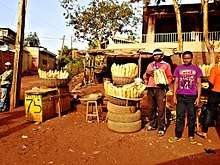Dschang
Dschang is a city located in the West (Ouest) Province of Cameroon, with an estimated population of 87,000 (est) in 2001, growing dramatically from 21,705 recorded in 1981.[1] The 2006 Population is estimated to be 200,000 inhabitants. Dschang is the capital of the division of Ménoua. The Bamiléké are the predominant ethnic tribe.
Dschang | |
|---|---|
 | |
 Dschang Location in Cameroon | |
| Coordinates: 5°27′N 10°04′E | |
| Country | |
| Region | West |
| Department | Menoua |
| Area | |
| • Total | 225 km2 (87 sq mi) |
| Elevation | 1,380 m (4,530 ft) |
| Population (2012) | |
| • Total | 76,524 |
| • Density | 340/km2 (880/sq mi) |
History
Colonial era
The documented history of Dschang began in 1895, when it was invaded by a German military mission. In 1909, the city replaced Fontem as the capital of a Germany military district. The region where Dschang now exists was then not the place of any major settlement but, instead, was an area that two bordering chiefdoms fought over. The name Dschang translates to "dispute" in the local language. However, some sources believe that Dschang was actually named after one of the chiefdoms which was already called "Tsang". "Tsang" in the local language has several meanings; one of the meanings is "dispute", another one is "pimple". It is unclear why the kingdom was named "Tsang" and long before the arrival of the Germans. A source believes that the real tanslation of "Tsang" as regards to the name of the this chiefdom is "pimple" because of the infiltration tactic used by this kingdom to conquer neighboring territories.
Following Germany's defeat in World War I, Cameroon became a British possession in 1917. The country was subsequently handed over to the French in 1920, who declared Dschang to be the capital of West Province, and developed the city's vacation resort in the 1940s. This resort now forms the basis of Dschang's plans to promote the city as a tourist destination.

Post-colonial era
On January 1, 1960, Cameroon became an independent state, and the regional administration was moved to the city of Bafoussam. Dschang suffered from this move, as much more effort was invested in the infrastructure of Bafoussam.
Following the opening of the Université de Dschang (University of Dschang) in 1993, however, foreign interest and developmental investment of the city began to increase, and plans for a drive to increase tourism and the exploitation of mineral deposits will contribute to the city's current development.
The current Mayor of Dschang is Baudelaire Donfack.
Economy and infrastructure

Due to its high elevation of over 1400 m,[2] Dschang is favoured by relatively cool temperatures and attractive scenery. It is therefore regarded as a mountain tourist resort. Since colonial times, Dschang has been an important agricultural center. Pig production plays a major role.
Deposits of the aluminum-bearing ore bauxite have been discovered nearby;[3][4] however, a lack of infrastructure has prevented full-scale mining operations to date.
Higher education
Since 1993, Dschang has a university with faculties for Agricultural Sciences; Economic Sciences and Business Management; Humanities; Law and Political Sciences; and Sciences. The Faculty for Agricultural Sciences, has been the first faculty and the university continues to be very strong in this thematic area.
Culture

The population of Dschang mainly speaks Yemba language,[6] a Bamileke language.
In early 2011, the Musée des Civilisations du Cameroun à Dschang was inaugurated.[7][8] This museum offers to discover the origin of the Cameroonian people and the diversity of the country's four large cultural domains via their history, but also their artistic productions, their architectures, and their political and social organizations.
 Dschang Municipal Lake
Dschang Municipal Lake Mamy Wata waterfalls
Mamy Wata waterfalls Nsem-Tsa waterfall in Dschange
Nsem-Tsa waterfall in Dschange Front view of the entrance to the Climate Center
Front view of the entrance to the Climate Center Climate Centre in Dschang
Climate Centre in Dschang Front view of the Nautical Base in Dschang
Front view of the Nautical Base in Dschang Inhabitants of Dschang
Inhabitants of Dschang Bread selling on a street in Dschang
Bread selling on a street in Dschang
References
- Encyclopædia Britannica
- Location & Climate
- Main economic indicators 1999-2000
- Bauxite find Archived September 27, 2007, at the Wayback Machine
- Airport of Dschang
- "Yemba.net - Online Dictionaries and Learning Tools for the Yemba Language". Aleco. 2012-03-13. Retrieved 2012-03-13.
- "Inauguration of the Museum of the Civilizations of Cameroon at Dschang". Archived from the original on 2011-11-04. Retrieved 2011-11-05.
- "Musée des Civilisations du Cameroun à Dschang". Archived from the original on 2011-10-07. Retrieved 2011-11-05.
